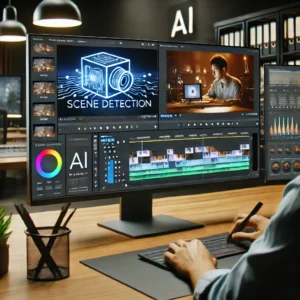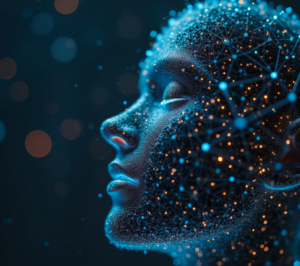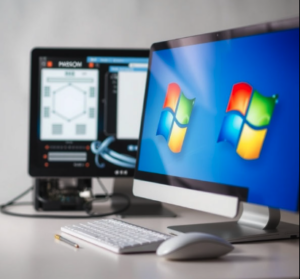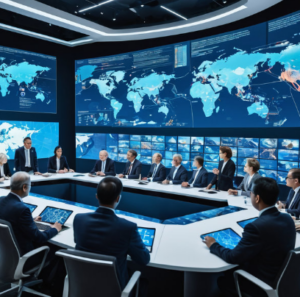
AI-generated media is transforming how content is created across industries like writing, music, art, and video production. This article explores AI’s impact on content creation, highlighting the benefits such as increased efficiency, personalization, and creativity.
AI-Generated Media
Artificial intelligence is revolutionizing content creation across various fields, including writing, music, art, and video production. AI-generated media tools are being embraced by creative professionals, businesses, and marketers for their efficiency and ability to automate routine tasks. These advancements are not only transforming how content is produced but also opening new possibilities in creativity and audience engagement. With AI tools generating music, writing articles, designing artwork, and editing videos, industries are rapidly evolving to integrate these technologies into their workflows.
The influence of AI in media creation raises questions about originality, copyright, and the role of human creativity. This article explores the different facets of AI-generated media, highlighting its benefits, challenges, and the ethical implications it brings to the content creation landscape.
How AI is Transforming Content Creation
AI-powered tools are enabling unprecedented speed and customization in content creation. Through machine learning algorithms, generative models, and natural language processing, AI can produce, edit, and refine content with minimal human intervention. These tools leverage large datasets to identify patterns and generate new content, leading to a range of applications across media.
1. AI in Writing and Content Generation
AI is already being used to produce written content at scale. Language models, such as OpenAI’s GPT, are capable of generating articles, social media posts, and even creative writing pieces. These models analyze massive datasets of human language to generate coherent and contextually relevant text.
- Automated News and Blog Writing: AI tools can generate news articles and blog posts by analyzing trending topics and relevant data. Media outlets like The Washington Post and Reuters use AI to assist journalists in producing quick news updates and summaries.
- Copywriting and Marketing Content: AI-driven platforms like Jasper and Writesonic are widely used for generating marketing copy, product descriptions, and social media content, saving time and costs for companies.
- Creative Writing Assistance: While AI cannot replace human creativity, it assists writers by providing ideas, suggestions, and structure, helping overcome writer’s block and improve productivity.
2. AI in Music Composition
AI has made significant strides in music production, enabling musicians and non-musicians alike to create original compositions. AI tools analyze existing music patterns and use machine learning algorithms to generate new sounds, melodies, and harmonies.
- AI Composers: Tools like AIVA and Amper Music allow users to compose original music by selecting styles, tempos, and instrument preferences. These AI systems use deep learning to produce compositions across genres.
- Music for Commercial Use: Companies often use AI-generated music for advertisements, films, and video games, where custom compositions are created quickly and cost-effectively.
- Collaborative Creation: Musicians are increasingly collaborating with AI systems to explore new sounds, blending human intuition with AI’s pattern recognition to innovate in their art.
3. AI in Visual Art and Design
AI-generated art has gained popularity, with applications ranging from digital illustrations to graphic design. AI models like DALL-E and Midjourney create original artwork based on text prompts, enabling designers and artists to quickly produce visuals that align with specific creative visions.
- Digital Illustrations and Artworks: Artists use AI-generated imagery as inspiration or for direct incorporation into projects. AI tools can generate a variety of art styles, providing flexibility in visual expression.
- Graphic Design and Branding: AI-driven platforms like Canva and Looka enable users to create logos, branding assets, and social media graphics with pre-built templates and AI-assisted customization.
- NFTs and Digital Collectibles: AI has become a key tool in the creation of non-fungible tokens (NFTs) and digital art, providing unique, generative pieces that collectors can buy, trade, and display in virtual galleries.
4. AI in Video and Film Production
AI has a transformative role in video and film production, making it easier to edit videos, enhance footage, and generate CGI. AI applications in this domain improve efficiency in post-production and allow creators to experiment with innovative visuals and narratives.
- Video Editing Automation: Tools like Adobe Premiere Pro and Runway use AI for automated video editing, scene detection, and color correction, streamlining post-production.
- Deepfake and CGI Generation: AI enables realistic CGI and deepfake technology, allowing filmmakers to create lifelike characters and scenes, sometimes controversially, for storytelling purposes.
- Personalized Video Content: Companies like Synthesia create AI-generated video content featuring synthetic characters, useful for personalized marketing, e-learning, and corporate communication.
The Benefits of AI-Generated Media
AI-generated media presents various advantages, especially in terms of efficiency, personalization, and scalability.
- Increased Efficiency and Speed: AI tools speed up the content creation process, enabling creators to produce high-quality work quickly, thus meeting tight deadlines and increasing productivity.
- Cost Reduction: AI can reduce the need for extensive human labor, cutting costs associated with hiring professionals for tasks like video editing, copywriting, and graphic design.
- Personalization and Customization: AI’s ability to analyze user data allows companies to generate personalized content tailored to individual preferences, improving engagement and user experience.
- Enhanced Creativity: By automating routine tasks, AI frees creators to focus on higher-level conceptual work, enabling experimentation and innovation.
Challenges and Ethical Considerations
The rise of AI-generated media also brings challenges and ethical concerns, particularly around issues of originality, ownership, and authenticity.
1. Copyright and Ownership Issues
One of the main challenges in AI-generated content is determining ownership. Who owns a piece of content created by an AI model—the developer, the user, or the AI tool? Legal frameworks struggle to keep up with these developments, leaving creators in a grey area regarding copyright claims.
- Content Ownership: Questions of authorship and copyright become complex when AI generates content based on existing works. Laws vary by region, and there’s a lack of consensus on intellectual property rights for AI-generated media.
- Licensing and Usage Rights: Companies using AI-generated content must ensure they comply with licensing agreements to avoid legal complications, especially when using pre-trained AI models with proprietary data.
2. Impact on Creative Jobs
AI’s ability to perform creative tasks raises concerns about job displacement for content creators. While AI can automate repetitive tasks, it risks marginalizing certain creative jobs, particularly for entry-level roles in design, writing, and production.
- Job Displacement: Roles in content creation, such as copywriters, video editors, and graphic designers, could face displacement or transformation due to AI capabilities.
- Human Creativity and Artistic Value: The widespread use of AI in creative industries prompts a re-evaluation of what constitutes human artistry and whether AI-generated content holds the same value as human-created work.
3. Authenticity and Trust
AI-generated media has the potential to blur lines between real and synthetic content. This ambiguity can create issues of trust, particularly in areas like journalism and advertising, where audiences expect authenticity.
- Misinformation: Deepfake technology, for instance, allows for realistic manipulation of audio and video, potentially spreading misinformation or altering public perception.
- Transparency: Content creators and companies must be transparent about the use of AI in media production to maintain audience trust and ensure that viewers understand the origins of the content.
Case Studies: AI in Action in Media Creation
Case Study 1: Automated Journalism with The Washington Post
The Washington Post uses an AI tool called Heliograf to cover sports, elections, and other topics with high data volumes. Heliograf generates short reports, saving journalists time and allowing them to focus on in-depth stories. This use of AI has allowed the newspaper to enhance its news coverage and engage readers with timely updates.
Case Study 2: AI in Film Production at Warner Bros.
Warner Bros. has used AI tools in film production for tasks such as predicting audience reactions and analyzing casting choices. By leveraging AI for predictive analytics, Warner Bros. optimizes marketing strategies and casting decisions, creating films that align with audience preferences.
Case Study 3: AI-Generated Music for Ads and Video Games by Amper Music
Amper Music, an AI-driven music platform, enables non-musicians to create custom music for videos, games, and ads. By choosing specific parameters, users can quickly generate background music that enhances the desired mood, cutting down the need for professional composers for small-scale projects.
Case Study 4: Deepfake Technology in Marketing by Synthesia
Synthesia uses AI to create synthetic video avatars that can speak in multiple languages, allowing brands to produce personalized and localized video content at scale. Synthesia’s technology has been utilized in corporate training, e-learning, and personalized marketing campaigns, illustrating AI’s role in mass customization.
Case Study 5: AI-Generated Visual Art in the NFT Space
Artists like Refik Anadol are leveraging AI-generated art to create digital installations and NFTs, merging machine creativity with human vision. By using AI tools to explore patterns and textures, Anadol produces generative art pieces that are visually captivating and uniquely digital, resonating with collectors and art enthusiasts alike.
The Future of AI-Generated Media
The future of AI-generated media is filled with possibilities, with advancements likely to impact both the scope of content creation and the definition of creativity itself. As AI tools become more sophisticated, the boundary between AI-generated and human-generated content will blur, leading to hybrid workflows where AI assists human creators in increasingly complex ways.
Potential future developments include:
- Increased Interactivity: AI may allow for more interactive and personalized media experiences, where users can customize storylines, visuals, and sounds in real time.
- Improved Quality and Realism: As AI models become more powerful, they will produce higher-quality, more realistic media, particularly in video and CGI applications.
- Enhanced Collaboration: AI will act as a creative partner, enabling artists and creators to explore new ideas that may be challenging to conceive without computational assistance.
FAQ
Q1: What are the main benefits of AI-generated media?
A1: AI-generated media increases efficiency, reduces production costs, enables personalization, and enhances creativity by automating routine tasks, allowing creators to focus on high-level conceptual work.
Q2: How is AI used in music production?
A2: AI generates original compositions by analyzing music patterns, creating melodies, and harmonies across genres. AI tools also produce background music for commercials, films, and video games.
Q3: What ethical challenges does AI-generated media present?
A3: Ethical challenges include copyright issues, job displacement, and potential misinformation. AI-generated media raises questions about content ownership and the role of human creativity.
Q4: How is AI impacting the job market in creative industries?
A4: AI has the potential to displace certain roles, particularly entry-level positions in content creation. However, it can also transform jobs by automating repetitive tasks and supporting creative innovation.
Q5: What is the future of AI-generated media?
A5: The future of AI-generated media includes advancements in interactivity, improved realism, and enhanced collaboration with human creators, reshaping the boundaries of creativity and content production.
AI-generated media continues to redefine content creation across various industries. While it offers numerous advantages, such as speed and personalization, it also brings challenges that require ethical consideration and adaptation in the creative workforce. As AI technology progresses, the integration of AI into media creation is likely to deepen, bringing transformative changes to the way we produce, share, and experience content.






